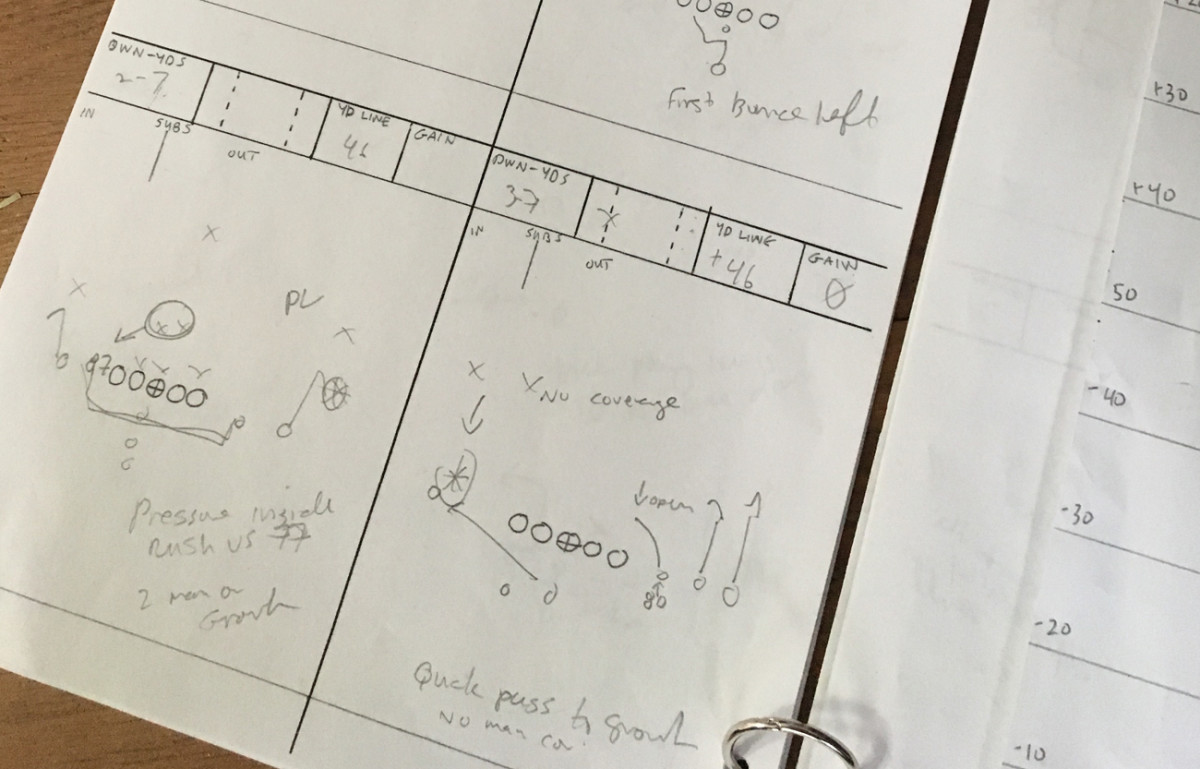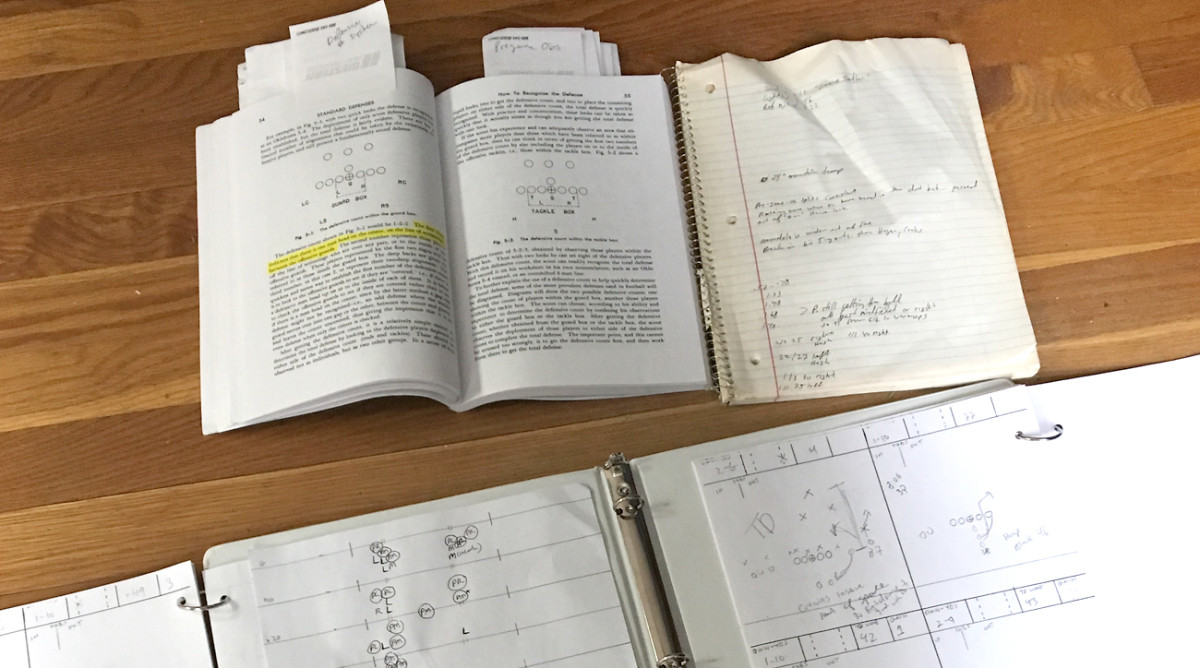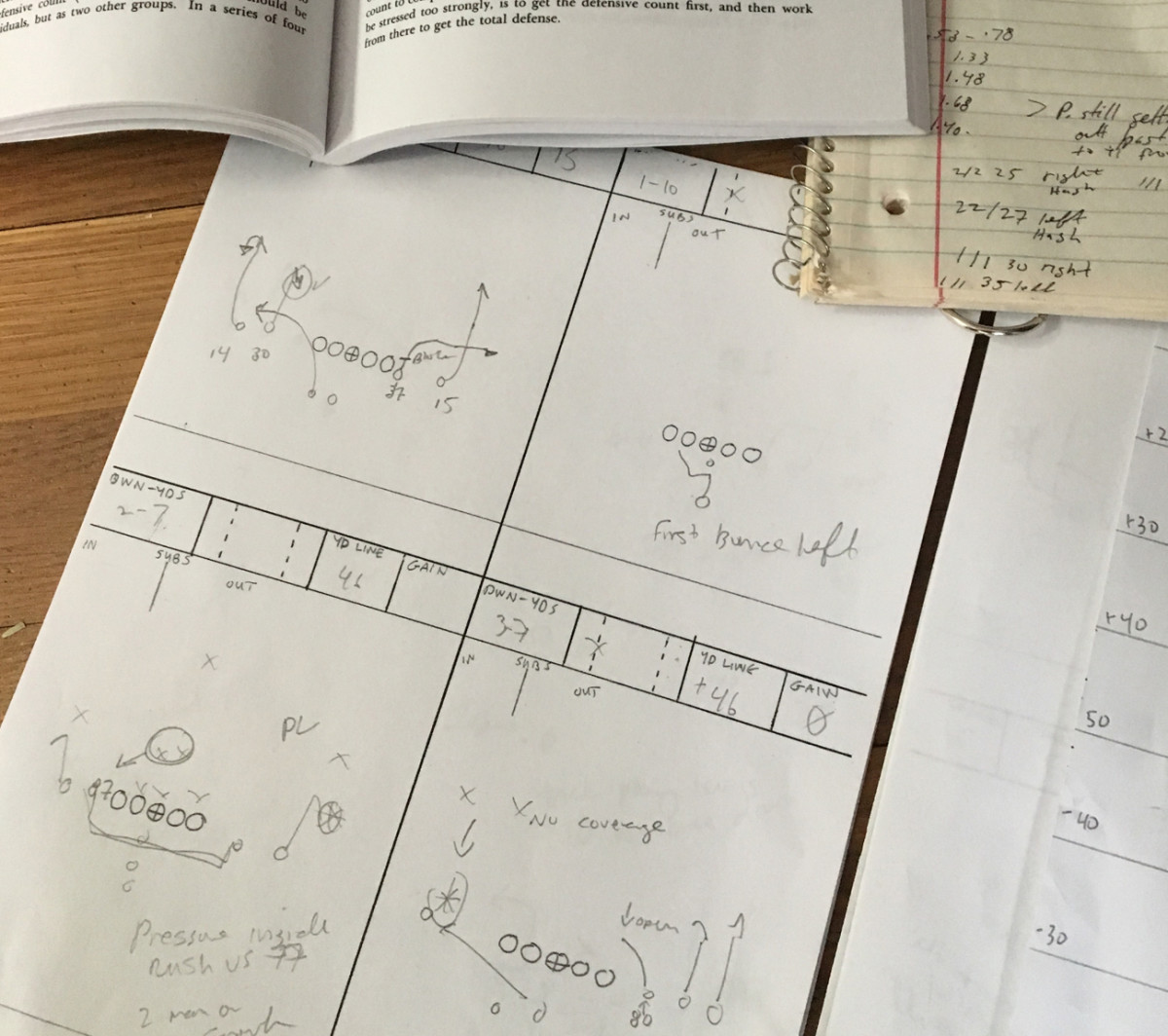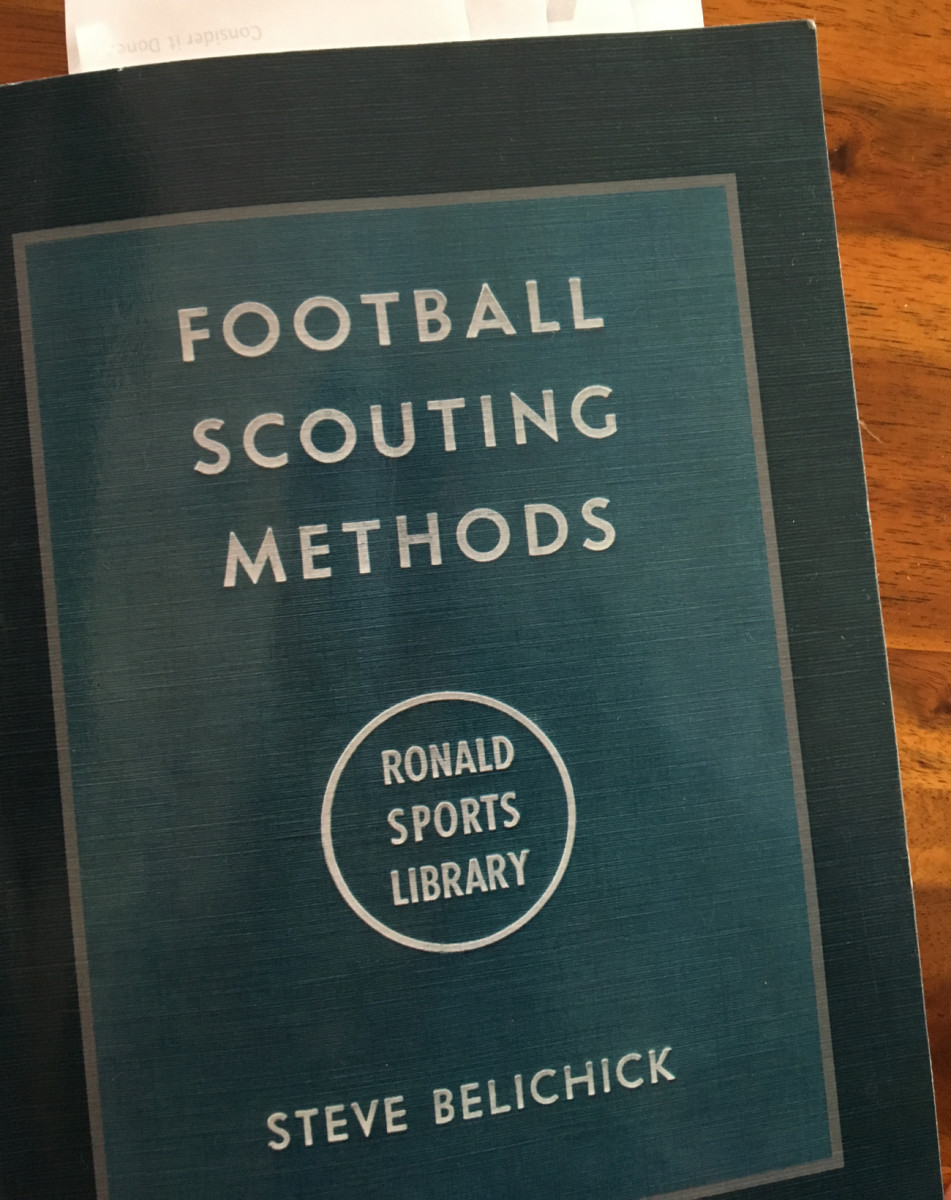I Scouted the Patriots Using Steve Belichick’s Scouting Manual. Here’s What I Learned

FOXBORO, Mass. — I felt my chances of getting hired by the Patriots slipping away.
My trial assignment—to analyze the divisional-round playoff game between New England and Tennessee at Gillette Stadium while abiding strictly by the guidelines of Steve Belichick’s seminal 1962 scouting manual, Football Scouting Methods—started well enough. I read and reread the instructions laid out by Bill’s father in this 182-page crash course on football theory—a book so important in the development of scouting that a jacket quote was provided by Paul Brown, the godfather of modern coaching. As suggested, I attempted a few trial runs with coach’s film.
On Saturday I managed to secure a seat “high in the stadium,” though not quite “perpendicular to the field” (blame the press box at Gillette, which sits reporters in the corner of the end zone opposite the light house). I arrived early enough to time how long it takes the punter, during practice, to complete the kick once the snap hits his hands (between 1.33 and 1.68 seconds). I tracked the placekicker’s success pregame (facing away from the lighthouse, he appeared to miss one of about a dozen kicks, pushing a field goal taken at the 40-yard line to the right. Facing the lighthouse, he hooked two from the left hash left of the post from about the 35 and 40, respectively, before nailing a third attempt with a lower, line drive kick). I marked how many steps the kicker takes to get to the ball (two, with the kick on the third pace). I also noted the types of routes run by receivers in warm-ups, since according to the manual those tend to be their favorite routes to run in games. Danny Amendola, for example, graduated from a series heavy on five-yard stops and outs to just one longer post pattern. Dwayne Allen was taking a noticeable number of passes on over-the-shoulder throws, or at least routes where his back was initially turned to the passer.
I came prepared, toting my “hard covered folder,” created to the exact specifications Steve lays out on Page 47: Put two holes on the right edge of the open folder or notebook so that two small book rings, size 9/16, can be used to hold the worksheets. Put corresponding holes on the right edge of the worksheet and attach with the rings to the folder. On the left edge of the open folder, make two holes to attach the other worksheets. On one side of the folder, you will have the offensive set of worksheets and on the other side, you will have the defensive.

He noted in the text that this was more “logical,” and helps avoid the “confusion that can and will take place.” Now, nothing runs together. The scout is organized.
Still, as the crowd fell silent and the national anthem began, I couldn’t help but feel a twinge of anxiety. Live football. I imagined myself in Steve Belichick’s world, scouting for Navy for all those years, more than three decades beginning in the ’50s. No replay in the press box. No Slingbox on the laptop. A family to feed at a time when coaching wasn’t as financially rewarding. Only moments—five-second bursts—of intense observation that had to be perfect.
My plan was akin to stealing the works of John Forbes Nash and trying to pass a course on game theory at Princeton. It felt flimsy all of a sudden. But short of pulling a fire alarm or killing the lights, there was nothing I could do to delay the start.
Page 96: RECEIVING THE KICKOFF
Once the receiving team is set for the kickoff and the ball is kicked (do not watch the kicker), maximum concentration should be directed to the five front men to see what they do. They are going to make their moves before the ends and the backs, since the latter must wait to see where the ball is going before they can initiate their action. These five front men, by their actions, will often quickly indicate what the direction of the return will be.
After the Titans blasted the opening kick out of the back of the end zone and Tom Brady took the field, I wondered which AC/DC song had played just after the anthem—a superfluous detail that clouded my headspace and diverted my attention.
That, too, was against the rules.
Page 26, paragraph four:Do not permit your interest to be aroused to the point that you become a spectator. This will hinder, and often prevent, you from obtaining essential information.
To understand Steve Belichick is to understand Bill. Imagining Football Scouting Methods being read in the Patriots coach’s terse, monotone press conference voice is to imagine William Faulkner in a southern drawl, or James Joyce with a brogue. It gives the words a third dimension. It brings to life theories about punt coverage.
Steve is the single greatest influence on the single greatest head coach in football history. Journalist and historian David Halberstam once wrote, “[Steve] was by all accounts a brilliant coach, an exceptional teacher and arguably the best and most professional scout of his era. No one, it was said, could scout another team and break down their film quite like Steve Belichick; no one could pick up on a giveaway mistake of another team—say, a runner who involuntarily gave a small tip-off before the snap when he was going to get the ball—like Belichick.”
And Bill was there next to him in the car, soaking up each thought and theory from the time he was seven years old. The first game Bill had an actual memory of was, fittingly, a 43-12 pounding of Army by the Naval Academy in 1959 at Memorial Stadium in Philadelphia. In front of 100,000 fans, Navy, no doubt armed with a bulletproof scouting report from Steve, and scored the most points in the series’ history—a margin that has only been topped twice since.
Steve’s ideas are exhausting and innovative. Before the days of high-resolution broadcasts or on-demand coaches film, he discovered and wrote about a fail-safe way of identifying a defense with just “four rapid looks”:
• Look 1: Defensive backfield to determine two or three deep coverage while the offense is breaking the huddle
• Look 2: The defensive players inside the “guard box”—a square area that encompasses both offensive guards and center.
• Look 3 &4: Two rapid looks to place the remaining players
His goal was to look away from the field as little as possible, often creating shorthand that allowed him to remain locked on the action without shifting down to his notebook even once. Everything was about creating more time and opportunity. The scouting report itself would give the staff a two-day jump on studying an opponent before the film arrived. The coding system would allow a few more seconds to jot down intricacies between plays. The methodical organization would make it easy to pack up, getting him down to the locker room to discuss what he saw with the coach or fellow scouts sooner.
Bill Belichick’s mantra—Do Your Job—has come to simply encapsulate the complex Patriot Way, but it seems so disproportionate to the weight of his father’s work. Steve Belichick wasn’t just doing his job. He was smashing it to pieces in secret and reengineering the parts. Teams were fighting with sticks and rocks back then. Steve had tanks and howitzers.
Against the Titans on Saturday night, the Patriots proved an immense challenge for a first-time Belichick-trained scout. They buzzed in and out of no-huddle offenses. As always, they employed a mind-numbing amount of pre-snap shifts to set up the play.
Coming into this game, New England presented 44 different personnel deployments on first down alone this year, according to NFL GSIS. They had 234 lineup combinations offensively and 307 on defense, and while those numbers aren’t astronomical by NFL standards, the low rate at which Belichick relies on any particular lineup creates the headaches for opposing coaches. (An example: With those 300 different defensive lineups this year, Belichick used the most common lineup only four percent of the time.)
It does not take a seasoned football mind to theorize that, after watching his father deliver the master class on opponent identification for 43 years, Bill did his best to prepare himself against the most experienced safe cracker, and not just the average thief.
Steve did leave some breadcrumbs in his book that are hard to for players to mask even after decades of refinement, though. Brady, for example does at times backpedal just a tad during his drop-back. In Football Scouting Methods, when a passer does that, “They are usually going to throw the ball to the left.” In rewatching Patriots games from this season, I picked 10 randomly selected, non-play action passing plays to the left side and found that seven times, when the receiver appearing to be Brady’s first read was on the left, he tended to backpedal with both shoulders facing the defense just slightly. I compared each pass to a standard drop-back where the intended receiver was on the right or over the middle, and it looked like Brady would settle into a more traditional, one-shoulder forward, sideways drop just a split second quicker.

That analysis took me an entire afternoon one weekday (Brady gets rid of the ball so quickly that I wonder if it even makes a difference to defenders in the area). Steve was picking these kinds of intricacies off at game speed.
His standard worksheet had four rectangular boxes per page. In each box, there were spaces to mark the down, yards to go, yard line and net gain. They also had a square with two dotted lines, allowing the scout to mark which hash the play was run from.
In the body of each rectangular area was a drawing of the team’s most common formation (if Navy was playing a T formation team, there would be pages and pages of a base T offense. The more a team motioned or varied its offense, the fewer players Belichick would draw into the forms before going to a game). He expected, on every play, to get not only the basic information, but also a rough outline of the play, intricacies of the offensive line (was a guard or center pulling?), substitutes and at least the routes of the play-side receivers.
Because of New England’s insane arsenal of offensive looks, the only players I had drawn in on each of my play sheets were the five offensive linemen. In a frantic effort to keep up with each snap, my binder took on the look of an Egyptian tomb drawing, strange scribbles that once had meaning to someone, words—BOUNCE TO THE RIGHT? CRACKDOWN!—that confounded even the author hours after the game.
Just the slightest wandering glance away from the field would put me at a profound disadvantage. By the time I’d gotten the hash, down, distance and yard line marked, and the remaining offense penciled in, Tom Brady, on cue, would approach the line, tap his helmet and orchestrate two or three shifts that would manipulate the defense in his favor and change the dynamic. It reminded me of the board game Perfection, where you spend all this time plugging puzzle pieces into corresponding slots before the timer dings and dozens of tiny plastic moons, stars and triangles explode onto the table.
More than a quarter in, I felt like a fraud; like the lead singer of a bar band trying to play Pet Sounds in its entirety. There is a level of artistry I was missing while going through the motions.
Still, I remembered what Steve wrote on Page 99, in a chapter about scouting the offense. At this point in the book, his list of things to look for on every snap became astronomical; a sign not only of how regimented and passionate he was, but how he himself must have bordered on genius.
Thankfully, he was not an unfair genius.
“In order to improve in scouting, every time the team comes up to the line of scrimmage one should try to condition himself to get or to check at least one more thing than the basic information—the formation, play action and the hole through which the play was run.”
One step at a time. Given the difficulty level, when I did hit on a nugget from the text, it was a moment of euphoria. For instance, in a section about offensive line scouting, Steve Belichick talked not only about the splits, but about tracking the tendencies of the offensive line based on pre-snap stance. Using some jet-option looks on Saturday, the Patriots were doing an exceptional job against Tennessee at establishing run threats while having their offensive linemen in passing stances (no hand in the dirt) before the snap.
My own definition of progress was probably more lenient than Steve’s. In Education of a Coach, Bill describes his father growing up in “a Draconian, unsparing world,” where the family harvested their own food, canned vegetables to survive the winter and relied on freelance butchering jobs for meat. Steve, the youngest of five, may have been the first kid in the family who was picked up and carried by his father after he’d learned to walk—and that was deemed evidence of “softening” at the time.

Knowing Steve’s background puts Football Scouting Methods in a different light. It’s well written, thoroughly researched and professionally generous—I cannot imagine Bill Belichick sharing so much of his processes at the height of his career. But there is also a surprising humility for someone who accomplished so much and started with so little. Steve rarely inserts himself into the text and always credits whatever head coach utilized the information he provided. Steve’s career path seemed to be motivated more by pride than by money or fame.
Layered in a passage about how, in order, a scout should watch a running play (start with the triangle formed by the two guards and fullback … utilize the time it takes the quarterback to step back to the running back to observe interior line play … ignore the handoff because it tells you nothing) Steve notes sternly: “It should also be remembered that although the play is over and the whistle has blown, the search for information should not cease.”
At some point in the book’s formation—Bill, through a spokesman, once told me it was actually dictated by Steve and written by his mother, Jeannette—I wondered if those last three words were underlined. Should. Not. Cease.
During this stage of football’s evolution, there were still scouts timing the 40-yard dashes of collegiate prospects by hand, and teams drafting players sight unseen based on stats from newspaper clippings. Steve was busting up game plans with charts, notes and diagrams.
Or, as he put it: “If a scout continues to use different methods and approaches and does some experimenting, he will eventually be rewarded by the detection of something of importance.”
A rough estimate at the end of four quarters: I made fireable errors on about 22 of New England’s 80 offensive snaps. Several times I forgot the hash mark. On one play in the first half, there’s nothing at all scratched into the workspace except for a large question mark. I whiffed on the substitution section altogether. I’m hoping my superiors just don’t ask about my thoughts on the Patriots’ defense before the film arrives. There were series where I’d still be jotting down furious notes about guard Joe Thuney’s exceptional ability as a lead blocker on pulling plays only to look up and find the Titans punting again.
On the drive back to my hotel, I thought about what I might tell the head coach if I’d stopped at a payphone to call the office and give my immediate analysis.
I might advise that our defensive ends keep their wits about them. On New England’s second touchdown drive, left tackle Nate Solder was battling with Brian Orakpo, who surged upfield and logged a quarterback pressure early in the series. The Patriots seemed to then turn Orakpo’s quickness against him by inviting him upfield and running in the space he created off the line. On James White’s 6-yard touchdown run, Orakpo was so far upfield that White simply had to bounce outside and allow Solder to set a basketball-style pick to force him off the path.
I might suggest keeping a close eye on Stephen Gostkowski pre-game, as he missed a kick Saturday similar to one he missed twice in the opposite direction in warm-ups.

I would let them know that, from the left hash inside the 50-yard line, the Patriots heavily favored running to the left side or the middle, almost never using the wide field for a running play. On their own side of the field, they were more balanced in the running game.
I would say that, per Steve’s instructions, I watched Rob Gronkowski doggedly to see if he tipped a passing play or a running play by the way he came off the line. My thought was that, while his first few moves are sometimes slightly different, he’s so large and powerful that if a defensive player doesn’t have great instincts, he’ll be flattened on the turf if he spends too long thinking about it.
I would key on Danny Amendola, Chris Hogan and the running backs. Their ability as receivers to motion the Patriots into advantageous man-on-man situations for Rob Gronkowski is jarring. So often they are feelers for Brady just to determine specific coverages. Amendola and Hogan’s talents run deeper, though. The two are some of the best, and most willing, downfield blockers I have seen. It’s extremely beneficial for their running game and short passing game.
Amendola, also, seems to relish the opportunity to run routes that purposefully suck in defenders that are supposed to be somewhere else. He can create space just as well as he can operate in it.

The appendix of Belichick’s book is the “Final Report,” and stretches from page 157 to page 182.
In an early section, it warns: IN CASE OF DOUBT, INDICATE THAT INFORMATION AS DOUBTFUL, OR AN OPINION. I thought about what it would be like to hand something in at the Naval Academy back in the 1960s with the word DOUBT!!!! written in size 72 font on the front page, just to temper expectations.
Some standard information, starting lineups, basic statistics and weather information bleed into a distribution chart that requires the scout to diagram each formation the team used, starting with the most preferential. Then, show the holes each back used on each play.
There is a blocking summary, which asks to provide the blocking type at the point of attack in each hole, and a particularly intimidating section that lists every pass receiver on the roster and asks the scout to diagram which routes they had run during the course of a game.
The final questions, which I will probably get to for this Titans-Pats game sometime after the Super Bowl, after steady 15-hour workdays and no time off, are as follows:
What are the strongest phases of the offense?
What are the weakest phases of the offense?
What are the strongest phases of the defense?
What are the weakest phases of the defense?
How would you rate the overall team speed?
What is the physical condition of the team in regard to injuries?
Is it a well conditioned football team?
Is the substitution by teams or individually?
How would you rate the overall depth of this opponent?
The easy part about scouting the Patriots is that so many of these questions can be answered in just a few words. Weaknesses on offense? Nope. Overall depth? Pretty freaking good. Remember David Harris? He wasn’t even active on Saturday; a cadre of running backs put up more than 100 yards and three touchdowns with Rex Burkhead injured. Good luck!
It made me wonder how many advance scouts have attempted a deep dive into the Patriots over the last 17 years—what they found and what they believed to be Achilles heels. It also made me think about how must have felt for them to watch their team get torn apart on Sunday after all the legwork. All this mind-numbing minutiae that ends up getting locked in a file cabinet somewhere. (The Patriots have won 214 regular season games under Belichick since 2000, and 26 in the playoffs).
Do the scouts who fail to crack the Patriots code have regrets? According to Steve, that should be expected.
Page 82:It must be remembered that a scout is not going to see all that he would like to see at a game.
Question or comment? Email us at talkback@themmqb.com.
